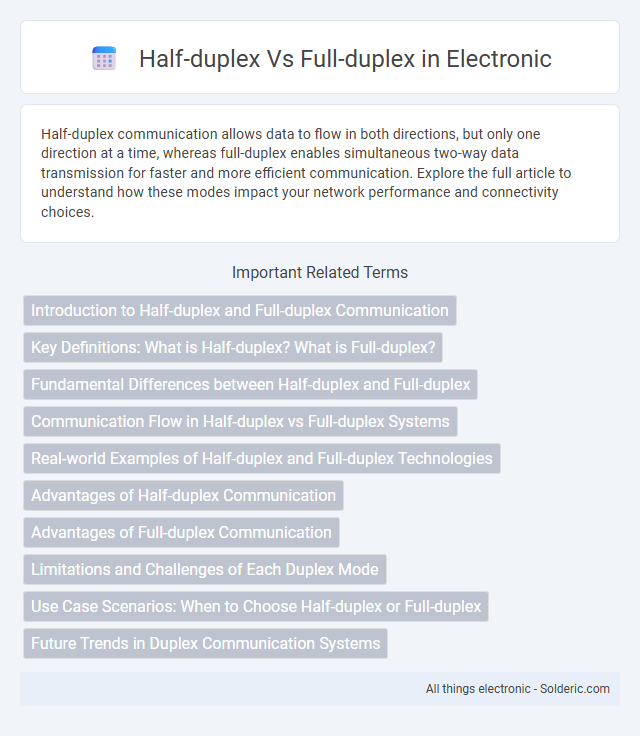Half-duplex communication allows data to flow in both directions, but only one direction at a time, whereas full-duplex enables simultaneous two-way data transmission for faster and more efficient communication. Explore the full article to understand how these modes impact your network performance and connectivity choices.
Comparison Table
| Feature | Half-duplex | Full-duplex |
|---|---|---|
| Communication Mode | Two-way, but not simultaneous | Two-way, simultaneous |
| Data Flow | One direction at a time | Both directions at the same time |
| Speed | Lower effective throughput | Higher effective throughput |
| Use Cases | Walkie-talkies, traditional Ethernet (CSMA/CD) | Telephones, modern Ethernet (full-duplex switches) |
| Complexity | Simple and cheaper | More complex and costly |
| Collision Handling | Required to avoid data collisions | No collision, simultaneous send/receive |
Introduction to Half-duplex and Full-duplex Communication
Half-duplex communication allows data transmission in both directions but only one direction at a time, commonly used in walkie-talkies and older Ethernet systems. Full-duplex communication enables simultaneous two-way data transfer, enhancing efficiency in modern networks like telephone calls and fiber optics. Understanding the difference helps you choose the right communication method for your network's speed and performance requirements.
Key Definitions: What is Half-duplex? What is Full-duplex?
Half-duplex communication allows data transmission in both directions, but only one direction at a time, meaning devices must take turns sending and receiving signals. Full-duplex communication enables simultaneous two-way data transfer, allowing your devices to send and receive information concurrently without waiting. Understanding these key definitions helps optimize network performance based on application requirements and communication efficiency.
Fundamental Differences between Half-duplex and Full-duplex
Half-duplex communication allows data transmission in both directions but only one at a time, requiring devices to alternate between sending and receiving. Full-duplex communication enables simultaneous two-way data transfer, increasing efficiency and reducing latency in network interactions. The fundamental difference lies in the transmission mode: half-duplex uses a single channel for bidirectional communication sequentially, whereas full-duplex utilizes separate channels or frequencies enabling concurrent transmission.
Communication Flow in Half-duplex vs Full-duplex Systems
Half-duplex systems allow communication in both directions but only one direction at a time, requiring devices to take turns to send and receive signals. Full-duplex systems enable simultaneous two-way communication, increasing efficiency by allowing data to flow continuously between devices without interruptions. Your network's performance depends on choosing the appropriate duplex mode based on communication flow needs and hardware capabilities.
Real-world Examples of Half-duplex and Full-duplex Technologies
Walkie-talkies exemplify half-duplex communication, allowing users to either transmit or receive signals at one time but not both simultaneously. Ethernet networks using twisted-pair cabling often support full-duplex communication, enabling devices to send and receive data concurrently, improving network efficiency. Mobile phone conversations operate on full-duplex channels, permitting both parties to speak and listen simultaneously without interruption.
Advantages of Half-duplex Communication
Half-duplex communication allows data transmission in both directions but not simultaneously, reducing the risk of collisions and simplifying hardware design. This mode conserves bandwidth by eliminating the need for separate transmit and receive channels, making it cost-effective for systems with limited resources. Half-duplex is advantageous in environments where network traffic is low or intermittent, optimizing signal integrity and reducing interference.
Advantages of Full-duplex Communication
Full-duplex communication allows simultaneous sending and receiving of data, which significantly increases the efficiency and speed of your network interactions. This mode reduces latency and improves overall bandwidth utilization, making it ideal for real-time applications like video conferencing and online gaming. Enhanced throughput and seamless data flow in full-duplex systems minimize collisions and interruptions, ensuring a more reliable and smooth communication experience.
Limitations and Challenges of Each Duplex Mode
Half-duplex communication faces limitations in simultaneous data transmission, as devices must alternate between sending and receiving, causing potential delays and collisions in busy networks. Full-duplex mode addresses these issues by enabling simultaneous two-way communication, but it requires more complex hardware and increased bandwidth, which can raise costs and implementation challenges. Interference and signal degradation remain challenges in full-duplex systems, necessitating advanced techniques like echo cancellation to maintain optimal performance.
Use Case Scenarios: When to Choose Half-duplex or Full-duplex
Half-duplex communication suits scenarios like walkie-talkies or older two-way radios where messages are sent in one direction at a time, reducing complexity and interference. Full-duplex is ideal for environments requiring simultaneous two-way data exchange, such as telephone calls or video conferencing, ensuring smooth and continuous communication. Your choice depends on the need for either simple, cost-effective communication or high-performance, real-time interaction.
Future Trends in Duplex Communication Systems
Future trends in duplex communication systems emphasize the shift towards full-duplex technology, enabling simultaneous two-way data transmission, which significantly boosts network efficiency and bandwidth utilization. Advancements in signal processing and interference cancellation techniques are paving the way for full-duplex integration in 5G and beyond, offering lower latency and higher throughput. Your communication infrastructure will increasingly benefit from these innovations, supporting the growing demand for faster, more reliable wireless connectivity.
Half-duplex vs Full-duplex Infographic

 solderic.com
solderic.com